

Hispanic Female-Owned Businesses On The Rise In Arizona
At about 8 o’clock on a recent Tuesday night, 36 small-business owners were working their second shift of the day at the Fuerza Local business accelerator.
The six-month-long program is for Spanish-speaking business-owners and is run by the Local First Arizona Foundation. The program trains small-business owners on the ins and outs of starting and running a business, from finances and budgeting to planning for growth, according to Edgar Olivo, the director of the program.
At the end of the program, each business will receive $1,000 to invest in their growth…
Link to article
WeHo’s John Duran Elected Chair of Latino Elected Officials Group
NALEO today announced the election of Duran as chair of its board and of two new members on the 15-member board. They are Jessica Herrera-Flanigan, executive vice president of government and corporate affairs at Univision Communications Inc. and Joseph “Pep” Valdes, executive vice president and director of new business development for Parking Company of America…
Link to article
Latino voters will reshape American politics as we know it — and here’s the proof
Twenty years ago, neither Democrats nor Republicans saw Latinos as a voting bloc worth wooing. Instead, they often pursued policies that actively played into xenophobia. In 1996, Bill Clinton signed into law the Illegal Immigration Reform and Immigrant Responsibility Act, which according to a recent Human Rights Watch report, set into motion today’s mass deportation. In that same year, future Chicago mayor Rahm Emanuel wrote a memo urging Clinton to “claim and achieve record deportation of criminal aliens.”
Over the last decade, the Democratic Party has changed its tune, and started trying desperately to woo Latinos. Today, leading Democrats overwhelmingly support a path to citizenship for undocumented immigrants, and are using executive orders to halt deportations, while Republicans, led by Donald Trump, continue to demonize Latinos and promise harsh countermeasures to stop undocumented immigrants from entering the country…
Link to article
Latino ‘Genius’ Grew Language-Learning App Duolingo to 150M Users
Ask Luis Von Ahn why he decided to become an entrepreneur and he will tell you that the career actually chose him. When he was a professor at Carnegie Mellon in 2005, he developed a program that websites could use to distinguish humans from robots. CAPTCHA became so popular that school officials urged Von Ahn to turn the program into something more.
“At some point the university was kicking the project out because it had too many users and they just said, ‘You can’t be in the university, you have to do something about it,'” he says. “I had to turn it into a company.”…
Link to article
Latino Theater Company Announces 2017 Season
LOS ANGELES: Latino Theater Company has announced its 2017 season at Los Angeles Theatre Center. The lineup will include three world premieres from local playwrights Jonathan Ceniceroz, John Pollono, and Diane Rodriguez, and the return of Encuentro, a festival and gathering of Latinx theatremakers…
Link to announcement
Mitú Partners With Snapchat To Create Content For Latino Youth
mitú, a digital network for Latino millennials, announced Monday the launch of its channel on Snapchat Discover. The new partnership will help Snap become a leader in delivering English language content with a Latino lens on Snapchat Discover…
Link to article
Mexican American Baseball in East Los Angeles
RA Santillán, R Peña, TM Santillán, A Padilla… – 2016 – books.google.com
Mexican American Baseball in East Los Angeles highlights the unforgettable teams, players,
and coaches who graced the hallowed fields of East Los Angeles between 1917 and 2016
and brought immense joy and honor to their neighborhoods. Off the field, these players and…
Link to book preview
New Mexico State University highlighted on list of Top 100 Colleges and Universities for Hispanics
According to the Top 100 Colleges and Universities for Hispanics list in the August 2016 edition of The Hispanic Outlook in Higher Education magazine, New Mexico State University has been recognized as one of the best institutions for Hispanics in the country.
Two women walk down the sidewalk.
This fall, the Hispanic Outlook in Higher Education magazine ranked New Mexico State University as a top institution for Hispanics in the nation. (NMSU photo by Darren Phillips)
Using data from the Department of Education (2014), NMSU ranked in the top 30 in both first major bachelor’s degrees granted (26th) and first major master’s degrees granted (21st). NMSU awarded 1,302 bachelor’s degrees (48 percent) to Hispanics, and 305 Hispanic students (38 percent) were awarded master’s degrees…
Link to article
An Honor of Note
Francisco Lomelí had no idea he was being considered for membership in a prestigious organization of Spanish language scholars. And then out of the blue word came that he was in. A professor of Spanish and Portuguese and of Chicana and Chicano studies at UC Santa Barbara, Lomelí was elected as a correspondent to the North American Academy of the Spanish Language. The honor is given to a small number of scholars who have distinguished themselves in their fields. Known by its Spanish acronym ANLE, the academy…
Link to article
Berkeley muralist draws from the personal and political for her art
BERKELEY — Spanning the side of a liquor store across from the Ashby BART station, Juana Alicia Araiza’s arresting mural is impossible to miss and even harder to ignore.
A screaming skull floats against a backdrop of turbulent ocean and burning sky. Skeletal animals bob lifelessly in polluted, oil-slicked waters. Painted in response to the 2010 Gulf of Mexico oil spill and the ongoing Dakota Access Pipeline confrontation at the Standing Rock Sioux Reservation, Araiza’s mural is a nightmarish vision of environmental degradation.
“That image came to me in 2010 when (the spill) happened, and then I was sick in 2013 and after that, I just felt really motivated to do the image,” Araiza said about her latest project begun during the recent Bay Area Mural Festival, which brought together master muralists, muralist groups and at-risk youths…
Link to article
Mexico President: NAFTA Benefits Both Sides of the Border
LIMA, Peru – Several U.S. allies expressed worry over what changes could take place when it comes to trade under president-elect Donald Trump’s administration at a summit of Asian-Pacific leaders in Peru on Saturday.
Mexican President Enrique Peña Nieto said NAFTA benefits workers and companies on both sides of the border. He expressed concern that the U.S. could be turning its back on a bilateral trade relationship responsible for moving $1 million worth of goods every minute…
Link to article
Access Latina is Looking to Boost Successful Latina Entrepreneurs
Latina entrepreneurs are among the fastest growing and industrious business owners in the United States, and one organization is looking to give a leg up to promising companies.
Access Latina, which is completely run by women, provides a platform for promising and pioneering Hispanic women who need capital or guidance to further grow their businesses. The platform seeks to uplift Hispanic women working in agriculture, social innovation and STEM fields…
Link to article
A Degree in Every Home
Jacki and Gilbert Cisneros, founders of educational outreach program Generation 1st Degree, bring Pico Rivera high schoolers and their parents to UCSB for a day of tours and talks…
Link to article
New mayor seeks cooperation, also higher developer fees
Developers with projects in the pipeline can expect to be asked to provide more affordable housing and a stronger community benefits package before being approved, Mayor-elect Jesse Arreguín said Monday during a far-ranging interview with Berkeleyside.
Now that the self-described progressives have the City Council majority (see below for more details) the “previous approach” to development will change, he said.
“I do think the voters wanted a change,”Arreguín said at PIQ on Shattuck Avenue. “That’s one of the reasons I was elected by such a large margin. One of the issues I heard throughout the city of Berkeley was a concern about the major demographic changes, the changes to the character of the place, long-time businesses being displaced, the scale of development.”
“I think the voters of Berkeley want more equitable, responsible growth,” he said. “That is not to say everything is going to come to a grinding halt. We need to create more housing so, certainly, under my administration, we are going to encourage the construction of transit-oriented development in Berkeley.”…
Link to article
The First Latina Senator is Ready to Be “One Hell of a Check and Balance” on Donald Trump
Former Nevada Attorney General Catherine Cortez Masto made history on Tuesday night when she became the first Latina to be elected to the Senate in U.S. history — and she’s already making it very clear she’s more than willing to go head-to-head with Donald Trump once she arrives in Washington, DC.
“Our government is built on a system of checks and balances, and I will promise you this: I will be one hell of a check and balance on him,” she said during her victory speech on Wednesday. “Tonight we start our fight together… The diversity here is our strength and we will continue to be strong.”…
Link to article
Mixtec Evangelicals
Many miles away from the popular Mexican seaside resort towns of Puerto Vallarta and Cabo San Lucas lie the poor, rural villages of Mexico’s Mixtec people, also known as “the People of the Land of the Rain.”
The Mixtecs originally developed communities isolated by the hilly Oaxacan terrain, with many remote villages accessible only on foot. The arrival of Spanish colonizers in the 1500s brought Catholicism to these communities, and it became a major force — both religious…
Link to article
Lost and Found
You might say there was something lost in translation when Santa Barbara named a street Canon Perdido. It should have been Cañon Perdido, after a cannon that disappeared on the beach in 1848. Without that Spanish enye Canon Perdido means something entirely different.
That twist of meaning is the theme of “Canon Perdido: XX Colloquium on Mexican Literature,” a three-day conference presented by the Department of Spanish and Portuguese at UC Santa Barbara. “We are playing with literary canon that is lost,” explained Sara Poot-Herrera, a professor in the department…
Link to announcement
Developing Hispanic-Serving Institutions Program – Title V
The Developing Hispanic-Serving Institutions (DHSI) Program provides grants to assist HSIs to expand educational opportunities for, and improve the attainment of, Hispanic students. These grants also enable HSIs to expand and enhance their academic offerings, program quality, and institutional stability
Applicant Information
Institutions must be designated as an eligible institution of higher education in order to apply for the Title V program and must meet the program-specific requirements to be defined as an HSI.
To be designated as an eligible institution of higher education, an institution must apply for and receive designation through an application process. Please refer to the most recent Application for Designation as an Eligible Institution. You may contact the program office if you have questions regarding eligibility….
Link to announcement
Mexican American Proarchive: Annual Report on Mexican American Professionals
News from the census American Community Survey is generally good for the 2015 year. Mexican American college enrollment was up from 18.7% to 18.9% in the 2014 and 2015 years. Graduate or professional degree attainment was also up from 2.9% to 3.0%. The number of bachelor’s degrees granted to Mexican American students rose from 7.6% in 2014 to 7.8% in 2015.


In spite of these gains, Mexican Americans still remain at the bottom of the ladder when it comes to earning a bachelor’s degree. Even after broadening the group to Latinos or Hispanics, this group still lags behind. According to the Pew Hispanic Center: “As of 2014, among Hispanics ages 25 to 29, just 15% of Hispanics have a bachelor’s degree or higher. By comparison, among the same age group, about 41% of whites have a bachelor’s degree or higher (as do 22% of blacks and 63% of Asians).” Pew reports that the main reasons for this low graduation rate is that Hispanics are less likely “to enroll in a four-year college, attend an academically selective college and enroll full-time.”
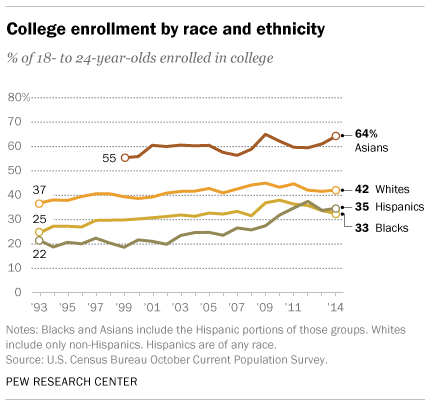
Also in the good news column, the University of California will continue to push for a greater number of underrepresented minorities; namely, Chicano/Latino students whose resident freshmen numbers rose from 2.7% to 32.3% of admitted California freshmen. In other good news, the proportion of Chicano/Latino students transferring from community colleges increased to 29.3% from 26.8% for 2015.
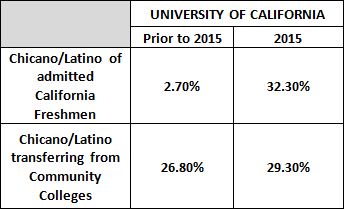
Occupations, including those in management, business, science, and art, fared better for Mexican Americans. The number of Mexican Americans filling these occupations rose from 17.4% in 2014 to 17.5% in 2015.

The total number of Hispanics filling these occupations was 16.1% in 2015, a bit lower than Mexican Americans specifically.
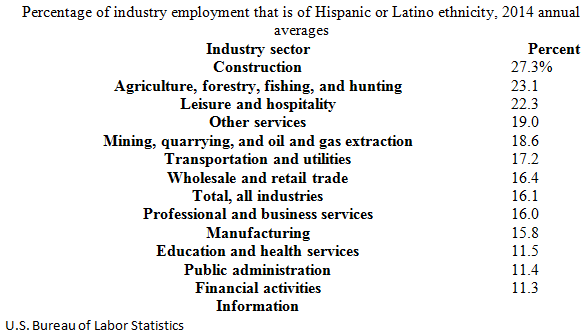
The report shows that industrial employment for Mexican Americans remained the same for 2014 and 2015 at 10.2%.
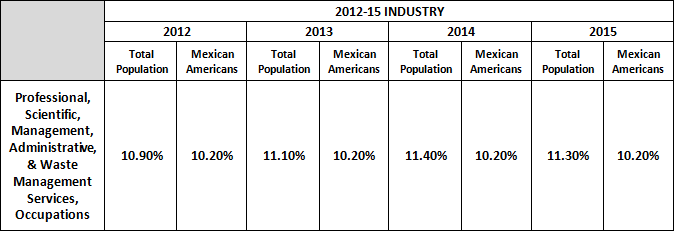
The figures for Hispanic or Latino employment for 2015 and 2016 show a healthy increase.
According to the Pew Hispanic center, “Construction, professional and business services, health services, financial services and food services…showed healthy gains.” Most of the jobs gained by native-born Hispanic workers were in manufacturing, mostly durable goods (82,000 Hispanic workers in this industry), followed by wholesale and retail trade (79,000), publishing, broadcasting, communication and information services (55,000), and construction (54,000).
Foreign-born Hispanics had the most job gains in construction (417,000), followed by business and professional services (179,000). Together, those two industries accounted for almost three-quarters (74%) of all jobs gained by foreign-born Latinos between 2005 and 2006.
The business and professional services sector, which ranges from management and technical services to janitorial, landscaping, and waste management services, is also a key employer for non-Hispanic workers. Of the total increase in employment in 2005-06, non-Hispanic workers accounted for 410,000 employees in the industry, native-born workers 327,000, and foreign-born workers 83,000.
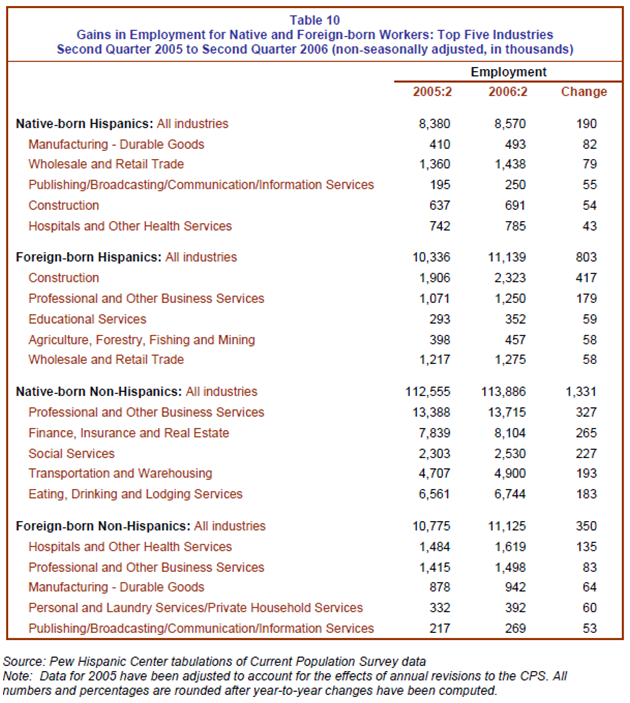
Sources
- Census Bureau, Selected Population Profile in the United States: 2015
- Pew Research Center
- University of California
- Bureau of Labor Statistics
Event speaker says Texas’ Hispanic community is an economic powerhouse that will only continue to grow
The Hispanic community is a growing part of the economic engine of Texas, marketing pro Terry Soto said at the annual Hispanic Business Achievers luncheon on Wednesday.
“To market to our community, thinking about a market that used to exist 10 or 20 years ago doesn’t work,” Ms. Soto explained. “We have to evolve our thinking and our approach to this community.”
Ms. Soto, president and CEO of About Marketing, has worked with Fortune 500 organizations including Walgreen’s, ALDI Supermarkets, Verizon Wireless Coca Cola, Citibank, Kraft Foods and Disney, among others. She told a capacity crowd at Harvey Convention Center that the Hispanic community will continue to grow as an economic and demographic force in Tyler and the rest of the nation…
Link to article


